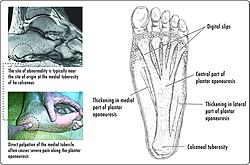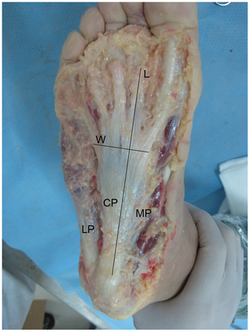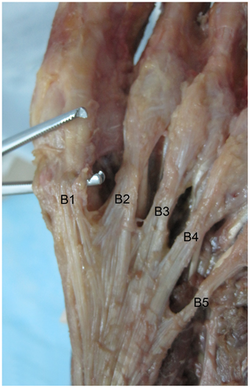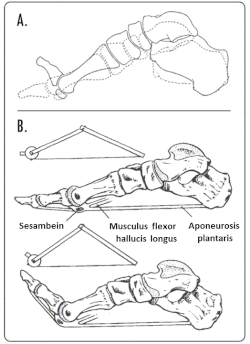Plantar fascia
| Plantar fascia | |
|---|---|
 Muscles of the sole of the foot. First layer (closest to the skin on the sole of the foot). Plantar aponeurosis visible at top center. | |
| Details | |
| Identifiers | |
| Latin | aponeurosis plantaris |
| TA98 | A04.7.03.031 |
| TA2 | 2718 |
| FMA | 45171 |
| Anatomical terminology | |
The plantar fascia or plantar aponeurosis
Anatomy


LP, lateral part; CP, central part; MP, medial part; L, length; W, width.

The plantar fascia is the thick central portion of the fascia investing the plantar muscles. It extends between the medial process of the tuber calcanei
Distally, the plantar fascia becomes continuous with the fibrous sheaths enveloping the flexor tendons passing to the toes. At the anterior extremity of the sole - inferior to the heads of the metatarsal bones - the plantar aponeurosis forms the
Structure
The plantar fascia is made up of predominantly longitudinally oriented collagen fibers. There are three distinct structural components: the medial component, the central component (plantar aponeurosis), and the lateral component (see diagram at right). The central component is the largest and most prominent.
Development
In younger people the plantar fascia is also intimately related to the
Function

The plantar fascia contributes to support of arch of the foot by acting as a tie-rod, where it undergoes tension when the foot bears weight. One
Gait
The plantar fascia also has an important role in dynamic function during
Clinical significance
Plantar fasciitis
- Plantar fasciitis is an often painful degenerative process of the plantar fascia.
- Calcaneal spur (heel spur) is a small calcified bone extension (osteophyte) located on the inferior aspect of the calcaneus or on the back of the heel at the insertion of the Achilles tendon. The condition is typically a response to plantar fasciitis over a period of time. It may also be related to ankylosing spondylitis, typically in children.
Other
- Plantar fibromatosis is a relatively uncommon non-malignant thickening of the plantar fascia.
- Psoriatic arthritis is a type of inflammatory arthritis that may affect the plantar fascia.
- Plantar fascial rupture/tear is a relatively uncommon painful tearing of the plantar fascia. The tear can be full or partial.[6]
Additional images
-
The plantar fascia (also known as the plantar aponeurosis) is located superficially plantar side of the foot.
See also
References
- ^ a b c "aponeurosis plantaris". TheFreeDictionary.com. Retrieved 2023-06-10.
- ISBN 978-1496347213.
- S2CID 45264072.
- S2CID 19194412.
- S2CID 2829705.
- ^ "Plantar Fascial Tears". American Foot & Leg Specialists. 2016-10-17. Retrieved 2018-04-23.
External links
- Plantar fascia at the Duke University Health System's Orthopedics program
- soleoffoot at The Anatomy Lesson by Wesley Norman (Georgetown University) (soleoffoot1)
- Heel Pain Symptoms. Plantar Fasciitis diagnosis and treatment | Patient; plantar fasciitis at Patient.info
